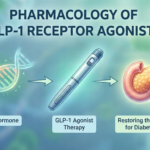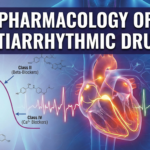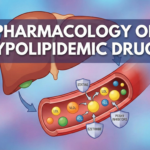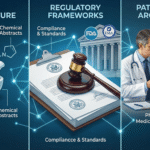Pharmacologic treatment of angina pectoris relies on antianginal agents that improve the myocardial oxygen supply–demand balance for symptom control and on adjunctive therapies tailored to mechanism (obstructive, vasospastic, microvascular), heart rate, blood pressure, and comorbidities under contemporary chronic coronary syndrome guidelines. Core antianginal classes include nitrates, beta-blockers, calcium channel blockers, late sodium current inhibition (ranolazine), sinus node If inhibition (ivabradine), and regional options such as nicorandil or metabolic modulation (trimetazidine), combined stepwise when monotherapy is insufficient.
Therapeutic objectives
- Rapidly abort acute episodes and prevent exertional attacks while minimizing adverse effects and drug interactions through mechanism-matched selection and dosing.
- Reduce long-term cardiovascular events with parallel use of antiplatelet, lipid-lowering, and renin–angiotensin–aldosterone blockade per guideline-directed care, recognizing that most antianginal agents themselves do not lower hard outcomes.
Nitrates
Mechanism and effects
- Organic nitrates biotransform to nitric oxide, activating soluble guanylate cyclase and increasing cGMP in vascular smooth muscle to promote venous capacitance and arterial dilation, thereby lowering preload and wall stress and increasing epicardial coronary caliber.
- Venodilation predominates at therapeutic doses, reducing left ventricular end-diastolic pressure and demand; higher doses add arteriolar and coronary vasodilation that can relieve spasm.
Formulations and use
- Sublingual nitroglycerin (0.3–0.6 mg) aborts attacks within minutes and may be used prophylactically before exertion; dosing can be repeated every 5 minutes up to 3 doses before urgent evaluation if pain persists.
- Long-acting nitrates (e.g., isosorbide mononitrate, isosorbide dinitrate, transdermal nitroglycerin) reduce attack frequency but require a daily nitrate-free interval of 10–12 hours to avoid tolerance.
Adverse effects and cautions
- Headache, flushing, dizziness, orthostatic hypotension, and reflex tachycardia are common and dose-related; methemoglobinemia is rare.
- Absolute contraindication with phosphodiesterase-5 inhibitors because of profound hypotension; avoid in right ventricular infarction and use caution in severe aortic stenosis or hypertrophic obstructive cardiomyopathy.
Role in angina
- Universal for immediate relief of episodes and as an add-on for prophylaxis when other first-line agents leave residual symptoms, including vasospastic angina where nitrates complement calcium channel blockers.
Beta-blockers
Mechanism and effects
- Competitive antagonism at cardiac β1 receptors lowers heart rate and contractility, prolongs diastole (improving subendocardial perfusion), and reduces systolic blood pressure, decreasing myocardial oxygen demand.
- Cardioselective, long-acting agents are favored for chronic control, with heart rate targets individualized to symptom relief and exercise tolerance.
Clinical use
- First-line for effort angina, especially with tachycardia, hypertension, prior MI, or LV systolic dysfunction, and as part of secondary prevention per guidelines.
- Avoid or use with caution in vasospastic angina (particularly nonselective agents), severe bradycardia, high-grade AV block, or decompensated heart failure.
Adverse effects and cautions
- Bradycardia, AV nodal conduction delay, fatigue, sexual dysfunction, and potential bronchospasm with nonselective agents; taper to avoid rebound ischemia.
Calcium channel blockers (CCBs)
Mechanism and subclasses
- L-type calcium channel blockade reduces calcium entry into vascular smooth muscle and myocardium, producing vasodilation (all CCBs) and rate/conduction slowing with non-dihydropyridines.
- Dihydropyridines (e.g., amlodipine) mainly dilate resistance vessels to reduce afterload; non-DHPs (verapamil, diltiazem) also decrease heart rate and contractility.
Clinical use
- First-line alternative to beta-blockers or in combination when monotherapy is inadequate; preferred in vasospastic angina and in patients with concomitant hypertension or beta-blocker intolerance.
- Avoid combining non-DHPs with beta-blockers in bradycardic or conduction-prone patients; dihydropyridines pair well with beta-blockers to mitigate reflex tachycardia.
Adverse effects
- Dihydropyridines: ankle edema, flushing, headache, and potential reflex tachycardia with short-acting agents; non-DHPs: bradycardia, AV block, constipation (verapamil), and drug–drug interactions via CYP and P-gp effects.
Ranolazine
Mechanism and pharmacology
- Inhibits the late inward sodium current in ischemic myocytes, secondarily decreasing calcium overload, diastolic wall stress, and microvascular compression without meaningful reductions in heart rate or blood pressure.
- QT interval can prolong modestly via IKr inhibition, requiring attention to concomitant QT-prolonging drugs and metabolic inhibitors.
Clinical use and dosing
- Add-on for persistent angina when heart rate or blood pressure limit beta-blockers/CCBs or when further hemodynamic effects are undesirable; also useful in diabetes where small HbA1c reductions occur.
- Extended-release 500 mg twice daily titrated to 1000 mg twice daily as tolerated, with dose constraints and monitoring when combined with moderate CYP3A inhibitors (e.g., diltiazem, verapamil).
Adverse effects and cautions
- Dizziness, nausea, constipation, and dose-related neurologic effects; avoid potent CYP3A inhibitors/inducers and use caution in hepatic impairment or significant renal dysfunction.
Ivabradine
Mechanism and pharmacology
- Selective inhibition of the sinus node If current lowers heart rate without negative inotropy or significant blood pressure reduction, thereby reducing myocardial oxygen demand in sinus rhythm.
- Heart-rate lowering is dose-dependent with common visual phosphenes and bradyarrhythmias, and metabolism via CYP3A4 drives interaction considerations.
Clinical use
- Consider when heart-rate reduction is needed and beta-blockers are contraindicated or inadequate, provided sinus rhythm is present and conduction is intact; not effective in atrial fibrillation.
- Typical dosing is 5–7.5 mg twice daily adjusted to heart rate and tolerability, with lower starting doses in bradycardia-prone patients.
Cautions
- Avoid with strong CYP3A4 inhibitors and in conduction disease or decompensated heart failure; monitor for bradycardia and atrial fibrillation.
Nicorandil
Mechanism and role
- Dual action as a nitrate donor and ATP-sensitive potassium channel opener yields arterial and venous vasodilation with potential ischemic preconditioning benefits.
- Effective for symptom relief and useful as an add-on when other classes are limited, particularly in vasospastic or mixed-mechanism angina.
Adverse effects
- Headache and flushing similar to nitrates, with mucocutaneous ulceration as a notable adverse effect requiring vigilance and discontinuation if severe.
Trimetazidine
Mechanism and role
- Metabolic modulator that shifts substrate utilization toward glucose oxidation, improving myocardial efficiency without hemodynamic effects.
- Used in some regions as add-on therapy for persistent symptoms when heart rate or blood pressure cannot be further altered by traditional agents.
Adverse effects
- Generally well tolerated; extrapyramidal symptoms are rare and more likely in older adults, warranting reassessment if movement disorders emerge.
Vasospastic and microvascular angina
Vasospastic angina (Prinzmetal)
- High-dose calcium channel blockers are first-line for preventing epicardial spasm, with short-acting nitrates for acute relief and optionally long-acting nitrates for additional prophylaxis.
- Avoid nonselective beta-blockers that may worsen spasm by unopposed alpha-mediated vasoconstriction in susceptible patients.
Microvascular angina (ANOCA/INOCA)
- Endotype-directed therapy includes beta-blockers or calcium channel blockers for impaired coronary flow reserve, plus ranolazine in selected patients to alleviate microvascular ischemia without further lowering blood pressure or heart rate.
- Contemporary guidance encourages invasive functional testing to phenotype microvascular dysfunction and tailor pharmacotherapy when symptoms persist.
Combination therapy and sequencing
Principles
- Combine agents with complementary mechanisms when monotherapy is inadequate, favoring beta-blocker plus dihydropyridine CCB, or adding ranolazine to either; avoid beta-blocker plus non-DHP CCB in bradycardic or conduction-prone patients.
- Long-acting nitrates can be layered for prophylaxis with strict nitrate-free intervals; ivabradine can substitute or supplement rate control when beta-blockers are not tolerated.
Guideline-led escalation
- Follow stepwise algorithms that start with beta-blocker or CCB (or both if appropriate), add a second class or ranolazine based on heart rate and blood pressure, then consider revascularization for refractory angina or prognostic indications.
Special clinical profiles
- Bradycardia or conduction disease: Prefer dihydropyridine CCBs, ranolazine, or nicorandil; avoid beta-blockers and non-DHP CCBs if symptomatic bradycardia or high-grade block is present.
- Hypotension: Ranolazine and ivabradine are attractive because they lack significant blood pressure lowering; nitrates and CCBs may aggravate hypotension.
- Hypertension: Beta-blockers and CCBs provide dual benefit on angina and blood pressure control, with dihydropyridine CCBs pairing well with beta-blockers for additive efficacy.
- COPD/asthma: Use cardioselective beta-blockers when indicated with caution, or consider ivabradine for rate control without bronchospasm risk.
Hemodynamic fingerprints (class effects)
Drug–drug interactions and safety checks
- Nitrates: Absolute contraindication with PDE5 inhibitors; caution with right ventricular infarction and preload-dependent states.
- Beta-blockers: Additive bradycardia with non-DHP CCBs and ivabradine; taper to avoid withdrawal phenomena.
- CCBs: Verapamil/diltiazem inhibit CYP3A4, raising concentrations of ivabradine and ranolazine; dihydropyridines can cause edema and reflex tachycardia if short-acting.
- Ranolazine: Avoid strong CYP3A4 inhibitors/inducers; limit dose with moderate inhibitors; monitor QT and metformin interaction at high doses.
- Ivabradine: Avoid strong CYP3A4 inhibitors and combination with verapamil/diltiazem due to bradycardia risk and increased exposure.
Syndrome-directed choices
- Obstructive effort angina: Start with beta-blocker or non-DHP CCB if tachycardic or hypertensive; add dihydropyridine CCB, long-acting nitrate, or ranolazine; consider revascularization if symptoms persist despite optimal medical therapy.
- Vasospastic angina: High-dose CCBs are first-line with short-acting nitrates for episodes and long-acting nitrates as needed; avoid nonselective beta-blockers.
- Microvascular angina: Use beta-blocker or CCB tailored to endotype and consider ranolazine for persistent symptoms; pursue functional testing for phenotype-directed therapy when available.
Practical dosing pearls
- Short-acting nitroglycerin: 0.3–0.6 mg sublingual at onset; repeat every 5 minutes to a maximum of three doses, then seek urgent care if pain persists.
- Long-acting nitrates: Schedule with a 10–12 hour nitrate-free window (e.g., overnight) to minimize tolerance while covering daytime exertion.
- Beta-blockers: Titrate to symptom relief and exercise tolerance while monitoring heart rate and blood pressure, prioritizing cardioselective, once-daily agents when possible.
- Ranolazine: Start 500 mg twice daily and increase to 1000 mg twice daily if tolerated; limit to 500 mg twice daily with moderate CYP3A inhibitors.
- Ivabradine: 5–7.5 mg twice daily in sinus rhythm with dose adjustments to heart rate and tolerability, avoiding strong CYP3A4 inhibitors.
Integration with guideline-directed care
- Antianginal pharmacotherapy is paired with event-reducing strategies: antiplatelet therapy, high-intensity statins ± ezetimibe/PCSK9 inhibitors, ACEI/ARB as indicated, and cardiometabolic agents in diabetes, within rehabilitation and risk-factor programs.
- Treatment algorithms emphasize shared decision-making, careful monitoring for bradycardia/hypotension and interactions, and timely referral for revascularization when symptoms remain unacceptable or anatomy/ischemia burden implies prognostic benefit.
References
- Vrints C, Andreotti F, Koskinas KC, et al. 2024 ESC Guidelines for the management of chronic coronary syndromes. Eur Heart J. 2024;45(36):3415–3537.
- Virani SS, Newby LK, Arnold SV, et al. 2023 AHA/ACC/ACCP/ASPC/NLA/PCNA Guideline for the Management of Patients With Chronic Coronary Disease. Circulation. 2023;148(9):e9–e119.
- Tarkin JM, Kaski JC. Pharmacological treatment of chronic stable angina pectoris. Clin Med (Lond). 2013;13(1):63–70.
- Kaski JC. Additional and emerging drugs for standard therapy for patients with stable angina. E-Journal Cardiol Pract. 2017;15.
- Kim KH, Adnan G, Schaller D. Nitroglycerin. In: StatPearls. Treasure Island (FL): StatPearls Publishing; 2023–2025.
- Lee PM, Gerriets V. Nitrates. In: StatPearls. Treasure Island (FL): StatPearls Publishing; 2023–2025.
- Reed M, Kerndt CC, Gopal S, et al. Ranolazine. In: StatPearls. Treasure Island (FL): StatPearls Publishing; 2025.
- Reed M, Patel P, Nicolas D. Ivabradine. In: StatPearls. Treasure Island (FL): StatPearls Publishing; 2025.
- Ritter JM, Flower R, Henderson G, et al. Rang & Dale’s Pharmacology. 10th ed. London: Elsevier; 2024. Ischemic heart disease pharmacology.
- Knuuti J, Fox K, et al. 2024 ESC guidelines on chronic coronary syndromes: pharmacotherapy update. Eur Heart J Cardiovasc Pharmacother. 2024;10(7):572–579.
📚 AI Pharma Quiz Generator
🎉 Quiz Results
Medical Disclaimer
The medical information on this post is for general educational purposes only and is provided by Pharmacology Mentor. While we strive to keep content current and accurate, Pharmacology Mentor makes no representations or warranties, express or implied, regarding the completeness, accuracy, reliability, suitability, or availability of the post, the website, or any information, products, services, or related graphics for any purpose. This content is not a substitute for professional medical advice, diagnosis, or treatment; always seek the advice of your physician or other qualified health provider with any questions you may have regarding a medical condition and never disregard or delay seeking professional advice because of something you have read here. Reliance on any information provided is solely at your own risk.









